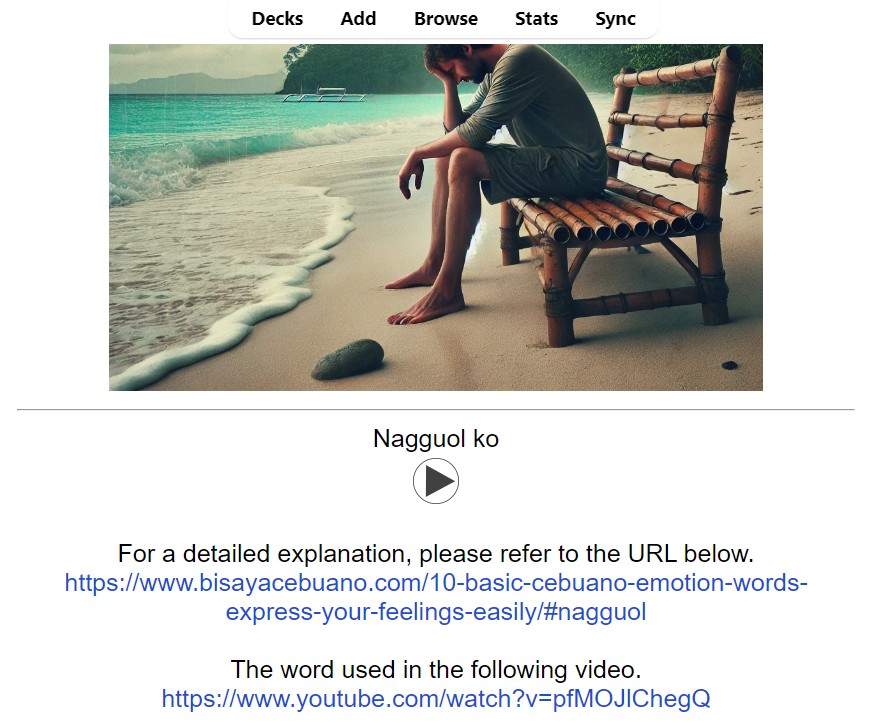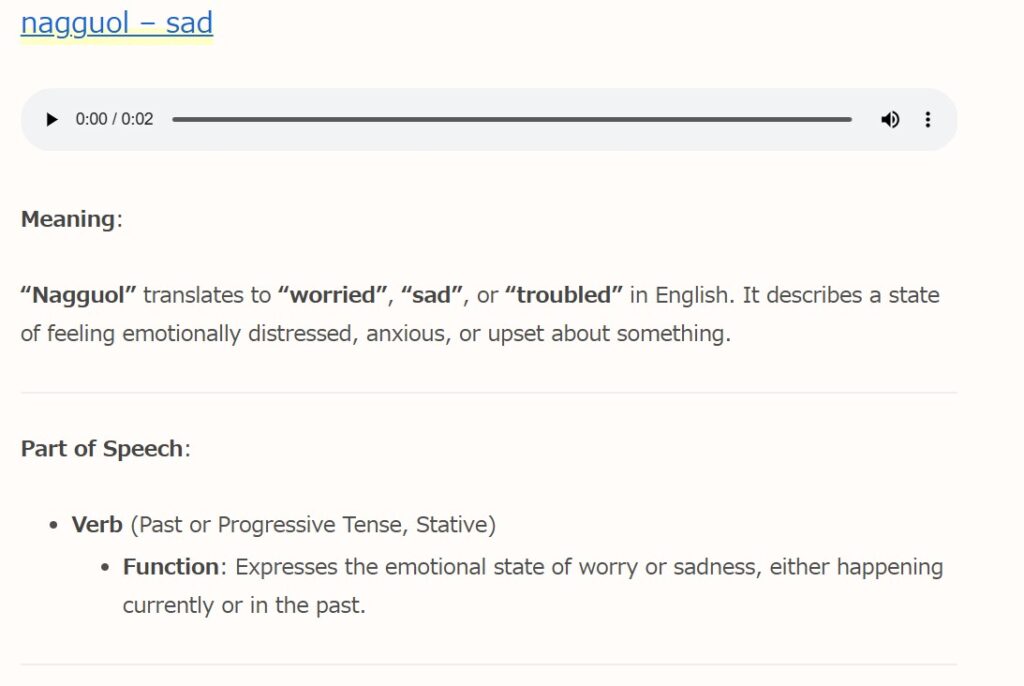Hello everyone! Welcome to ‘Speak Like a Local: Perfect Your Shopping English in 10 Minutes.’ Today we’ll learn how to have everyday conversations about shopping. In just 10 minutes, you’ll learn the tricks to conversing as naturally as a native speaker. We’ll develop skills for keeping a natural flow in conversations with friends about shopping—what you bought, where you bought it, and why you chose that item. By the end of this video, you should be confident participating in English conversations about shopping-related topics. Now, let’s get started!


*This learning material is designed with the assumption that you will be having lessons with Filipino wife, husband, boyfriend, girlfriend, friends, or language teachers.
- Today’s Goal
- Vocabulary
- Flashcards
- Dialogue Practice
- Expressions
- Comprehension Quiz
- Word Order Exercise
- Phrase Matching Exercise
- Fill in the Blank Exercise
- Review
- Answer
- Cebuano Sentence Breakdown with Word Meanings, Parts of Speech, and Example Sentences
- 🗣 Original Conversation
- 🔍 Phrase-by-Phrase Breakdown with Parts of Speech, Usage, and Example Sentences
Today’s Goal
This conversation can teach you:
How to discuss recent shopping experiences, including asking about and explaining purchases (types of items, brands, and reasons for purchasing)
How to express interest in someone else’s shopping choices and share your own preferences, which helps maintain a natural flow in casual conversation
Vocabulary
- Meaning: went out for fun, wandered around, hung out, strolled
- Part of speech: verb (past/progressive tense of laag)
- Usage:
Used to describe going out casually — for fun, socializing, sightseeing, or just strolling. It implies a non-serious, leisurely activity.
Example Sentences:
- Naglaag mi sa mall kagabii.
– We hung out at the mall last night. - Ngano wa ka sa balay? Naglaag ka?
– Why weren’t you at home? Were you out wandering? - Kapoy na ko, sige kog laag kada adlaw.
– I’m tired. I’ve been going out every day.
- Meaning: bought, purchased
- Part of speech: verb (past tense, passive voice)
- Root word: palit – to buy
- Prefix: gipa- (past tense, passive focus)
- Usage: Used when referring to something that was bought or has been purchased, often emphasizing the object that was bought rather than the person doing the action.
Example Sentences:
- Asa ang mga prutas nga gipamalit nimo?
– Where are the fruits that you bought? - Ang bag nga iyang gipamalit kay mahal.
– The bag that she bought is expensive. - Gipamalit ni mama ang mga sud-an sa merkado.
– Mom bought the dishes at the market.
- Meaning: that, which, who, of, linking word
- Part of speech: particle / linker / conjunction
- Usage:
- nga is one of the most common and versatile words in Cebuano.
- It is mainly used as a linking word between:
- adjective + noun
- noun + clause
- verb + object clause
- Similar to the English words “that,” “which,” “who,” or simply acts as a connector in a sentence.
Common Uses & Example Sentences:
- Linking Adjective + Noun
- Lami nga pagkaon.
– Delicious food.
(lami = delicious, pagkaon = food)
- Lami nga pagkaon.
- Linking Noun + Clause
- Ang bata nga nagsinggit.
– The child who is shouting.
- Ang bata nga nagsinggit.
- Clarifying Ownership or Description
- Ang balay nga pula.
– The house that is red.
- Ang balay nga pula.
- With Verbs (Object clause)
- Nakita nako ang salida nga imong gisulti.
– I saw the movie that you were talking about.
- Nakita nako ang salida nga imong gisulti.
- Part of Speech: Adjective phrase
- Meaning: new
- Usage:
In Cebuano, “bag-o” means new and is used to describe something recent or newly acquired. When modifying a noun, “nga” is added as a linker between the adjective and the noun — similar to saying “new [thing]” in English.
Structure:
bag-o nga + noun
Examples:
- Bag-o nga sapatos – new shoes
- Bag-o nga magtutudlo – new teacher
- Bag-o nga trabaho – new job
- Bag-o nga proyekto – new project
- Bag-o nga estudyante – new student
- Meaning: shoes
- Part of Speech: noun
- Usage: Refers to footwear worn on the feet, often used in everyday conversation about clothing or shopping.
Example Sentences:
- Nindot imong sapatos!
– Your shoes are nice! - Gipalit nako kini nga sapatos sa mall.
– I bought these shoes at the mall. - Wala ko nagdala og sapatos, tsinelas ra.
– I didn’t bring shoes, just slippers.
- Meaning: class, type, kind
- Part of Speech: noun
- Usage:
- Refers to a class in school or any group-based learning session.
- Can also mean a type or kind of something, depending on context.
Example Sentences:
- Naa koy klase karong buntag.
– I have class this morning. - Unsang klase sa isda imong ganahan?
– What kind of fish do you like? - Human na ang among klase.
– Our class is finished.
- Meaning: bought, was bought
- Part of Speech: verb (past tense, passive voice)
- Root Word: palit (to buy)
- Usage: Used to refer to something that was bought, often emphasizing the item rather than the person buying.
Example Sentences:
- Asa ang gipalit nimo nga libro?
– Where is the book you bought? - Ang gipalit niya kay mahal kaayo.
– What he/she bought was very expensive. - Gipalit ni papa ang prutas sa merkado.
– Dad bought the fruits at the market.
- Meaning: like, enjoy, be fond of
- Part of Speech: verb
- Usage:
Used to express liking or preference for something. Often followed by “og” or “sa” plus the object of affection or interest.
Example Sentences:
- Ganahan ko og kape.
– I like coffee. - Ganahan siya sa iyang bag-ong sapatos.
– She likes her new shoes. - Ganahan ba ka moadto sa baybay?
– Do you want to go to the beach?
- Meaning: of, with, by, for, or used to introduce the object of the verb
- Part of Speech: preposition / linker
- Usage:
“og” is a versatile word in Cebuano, commonly used to:- introduce direct objects after verbs
- connect verbs/adjectives to nouns
- function like the English word “some” or “a” in certain contexts
Example Sentences:
- Ganahan ko og tsokolate.
– I like chocolate. - Nagbasa siya og libro.
– He/She is reading a book. - Mipalit ko og tinapay.
– I bought some bread.
- Meaning: maybe, perhaps, might
- Part of Speech: adverb
- Usage:
Used to express possibility or uncertainty. Similar to “maybe” or “might” in English. Often placed at the beginning of the sentence.
Example Sentences:
- Basin moabot siya unya.
– Maybe he/she will arrive later. - Basin uwanon karon.
– It might rain now. - Basin malangan ko.
– I might be late.
- Meaning: will go, going to (a place)
- Part of Speech: verb (future tense, actor focus)
- Root Word: adto (to go)
- Usage:
“Muadto” is used when someone plans or intends to go somewhere. It’s a future tense form and usually followed by a destination (often with sa).
Example Sentences:
- Muadto ko sa eskwelahan ugma.
– I will go to school tomorrow. - Muadto mi sa mall karong hapon.
– We’re going to the mall this afternoon. - Muadto ba ka sa party?
– Are you going to the party?
- Meaning: there (in that place), over there
- Part of Speech: adverb
- Usage:
Used to refer to a place previously mentioned or far from the speaker, similar to “there” in English. Often used when talking about past locations or specific destinations.
Example Sentences:
- Didto ko nagpuyo sauna.
– I used to live there before. - Asa ka gikan? Didto sa merkado?
– Where did you come from? From the market? - Nagkita mi didto sa simbahan.
– We met there at the church.
- Meaning: tomorrow
- Part of Speech: adverb
- Usage:
Used to talk about events or actions that will happen the next day. Often placed at the beginning or end of a sentence.
Example Sentences:
- Muadto ko sa eskwelahan ugma.
– I will go to school tomorrow. - Ugma pa ang among exam.
– Our exam is still tomorrow. - Makita tika ugma.
– I’ll see you tomorrow.
Flashcards
We have created the Anki app file. Every word shows an associated image. You can hear the pronunciation of every word. All words are explained grammatically, so you don’t have to memorize them by heart. You can remember the words by logic. You can download the App and the file from the URL below.



Dialogue Practice
Tinaytina: Kumusta ka? Naglaag ba ka sa mall karong hapon?
Dave: Oo, naa ko’y gipamalit nga bag-o ng sapatos.
Tinaytina: Mao ba? Unsa man nga klase imong gipalit?
Dave: Nike, kay sale man karon. Ganahan ba ka og Nike?
Tinaytina: Oo, ganahan kaayo ko! Basin muadto ko didto ugma.
Expressions
Naglaag ba ka sa mall?
- Meaning:
- Did you go to the mall?
Situational Usage
- Asking Someone About Their Current Location:
- Naglaag ba ka sa mall karon?
- Are you at the mall now?
- Naglaag ba ka sa mall karon?
- Curious About a Friend’s Activity:
- Naglaag ba ka sa mall kagahapon?
- Did you go to the mall yesterday?
- Naglaag ba ka sa mall kagahapon?
- Checking Plans:
- Naglaag ba ka sa mall o naa ka sa balay?
- Are you at the mall or at home?
- Naglaag ba ka sa mall o naa ka sa balay?
Possible Responses
- Oo, naa ko sa mall karon.
- Yes, I’m at the mall now.
- Wala, naa ra ko sa balay.
- No, I’m just at home.
- Oo, naglaag mi sa mall ganina.
- Yes, we went to the mall earlier.
Ganahan ba ka og ~?
- Meaning: “Do you like ~?”
Situational Usage
- Asking About Preferences:
- Ganahan ba ka og isda?
- Do you like fish?
- Ganahan ba ka og isda?
- Offering Something:
- Ganahan ba ka og kape?
- Would you like some coffee?
- Ganahan ba ka og kape?
- Casual Conversations:
- Ganahan ba ka og horror movies?
- Do you like horror movies?
- Ganahan ba ka og horror movies?
Possible Responses
- Oo, ganahan ko.
- Yes, I like it.
- Dili, salamat.
- No, thank you.
- Medyo ganahan ko, pero dili kaayo.
- I kind of like it, but not too much.
Naa ko’y gipamalit.
- Meaning: “I have bought something.”
Situational Usage
- Mentioning a Recent Purchase:
- Naa ko’y gipamalit sa grocery.
- I bought something from the grocery.
- Naa ko’y gipamalit sa grocery.
- Explaining Why You Have These Items:
- Naa ko’y gipamalit para sa among parti.
- I bought something for our party.
- Naa ko’y gipamalit para sa among parti.
- Answering Someone’s Question:
- Unsa’y imong gipamalit?
- What did you buy?
- Naa ko’y gipamalit nga isda.
- I bought some fish.
- Unsa’y imong gipamalit?
Possible Responses
- Unsa imong gipamalit?
- What did you buy?
- Tagpila man ang imong gipamalit?
- How much did you pay for what you bought?
- Ay, maayo! Para kinsa man?
- Oh, that’s good! Who is it for?
Comprehension Quiz
- Asa si Dave niadto karong hapon?
(Where did Dave go this afternoon?) - Unsa ang gipalit ni Dave sa mall?
(What did Dave buy at the mall?) - Ngano nga gipili ni Dave ang sapatos nga Nike?
(Why did Dave choose Nike shoes?)
Word Order Exercise
Rearrange the words to form a correct sentence:
Q1.ka / Kumusta / ?
Q2.ko’y / naa / gipamalit / sapatos / nga / bagong / ko
Q3.unsa / imong / man / gipalit / nga / klase / ?
Q4.ba / ganahan / ka / Nike / og / ?
Q5.ko / muadto / didto / ugma / basin
Phrase Matching Exercise
Directions: Match each phrase in Column A with its correct meaning or continuation in Column B.
| Column A | Column B |
|---|---|
| 1. Kumusta ka? | a. Maayo ra ko, salamat. |
| 2. Naglaag ba ka sa mall karong hapon? | b. Oo, naa ko’y gipamalit nga bagong sapatos. |
| 3. Naa ko’y gipamalit nga bagong sapatos. | c. Mao ba? |
| 4. Unsa man nga klase imong gipalit? | d. Nike, kay sale man karon. |
| 5. Ganahan ba ka og Nike? | e. Oo, ganahan kaayo ko! |
Fill in the Blank Exercise
Directions: Fill in the blanks with the correct word(s) from the original Cebuano conversation. The English meaning is provided for reference.
1. Kumusta ___?
How are you?
2. Naglaag ba ka sa ___ karong hapon?
Did you go out to the mall this afternoon?
3. Oo, naa ko’y gipamalit nga ___ ___.
Yes, I bought a new pair of shoes.
4. ___ ba ka og Nike?
Do you like Nike?
5. Basin ___ ko didto ugma.
Maybe I will go there tomorrow.
Review
Instruction: Try to answer in Cebuano.
1.
What kind of shoes did Dave buy, and why did he choose that brand?
2.
What did Tinaytina say after Dave mentioned he bought new shoes?
3.
Can you make your own sentence using the pattern: “Ganahan ba ka og ___?”
(Example: Ganahan ba ka og kape?)
Answer
- Asa si Dave niadtong hapon?
(Where did Dave go this afternoon?)
Cebuano Answer: Niadto si Dave sa mall.
Answer: Dave went to the mall. - Unsa ang gipalit ni Dave sa mall?
(What did Dave buy at the mall?)
Cebuano Answer: Nipalit si Dave og bag-ong sapatos nga Nike.
Answer: Dave bought a new pair of Nike shoes. - Ngano nga gipili ni Dave ang sapatos nga Nike?
(Why did Dave choose Nike shoes?)
Cebuano Answer: Tungod kay sale man.
Answer: Because they were on sale.
A1. Kumusta ka?
A2. Naa ko’y gipamalit nga bagong sapatos.
A3. Unsa man nga klase imong gipalit?
A4. Ganahan ba ka og Nike?
A5. Basin muadto ko didto ugma.
| A | B |
|---|---|
| 1 | a |
| 2 | b |
| 3 | c |
| 4 | d |
| 5 | e |
- ka
- mall
- bagong sapatos
- Ganahan
- muadto
Cebuano Sentence Breakdown with Word Meanings, Parts of Speech, and Example Sentences
承知しました。以下は、最初にご提示いただいたセブアノ語の会話文を品詞分解し、使用される場面の説明と**例文(1文)**を英語で加えた解説です。
🗣 Original Conversation
Tinaytina: Kumusta ka? Naglaag ba ka sa mall karong hapon?
Dave: Oo, naa ko’y gipamalit nga bagong sapatos.
Tinaytina: Mao ba? Unsa man nga klase imong gipalit?
Dave: Nike, kay sale man karon. Ganahan ba ka og Nike?
Tinaytina: Oo, ganahan kaayo ko! Basin muadto ko didto ugma.
🔍 Phrase-by-Phrase Breakdown with Parts of Speech, Usage, and Example Sentences
1. Kumusta ka?
- Kumusta (interjection) – “Hello” or “How are you?”
- ka (pronoun) – “you” (singular, informal)
Usage: Used when greeting someone in a casual setting, like friends or classmates.
Example:
Cebuano: Kumusta ka, Ana?
English: How are you, Ana?
2. Naglaag ba ka sa mall karong hapon?
- Naglaag (verb, past/progressive) – went out / strolled / hung out
- ba (particle) – question marker
- ka (pronoun) – you
- sa (preposition) – at/to
- mall (noun) – shopping mall
- karong (adverb) – this
- hapon (noun) – afternoon
Usage: Used to ask if someone went out casually, especially to public places.
Example:
Cebuano: Naglaag ba ka sa plaza kagabii?
English: Did you go out to the plaza last night?
3. Oo, naa ko’y gipamalit nga bagong sapatos.
- Oo (interjection) – yes
- naa ko’y = naa ko’y → (phrase) “I have”
- naa (verb/existential) – there is/are
- ko’y = ako’y – contraction of ako +’y (I have)
- gipamalit (verb, past tense) – bought
- nga (linker/conjunction) – that
- bagong (adjective) – new
- sapatos (noun) – shoes
Usage: Used when telling someone that you bought something recently.
Example:
Cebuano: Naa ko’y gipamalit nga libro gahapon.
English: I bought a book yesterday.
4. Mao ba?
- Mao (expression) – “Is that so?”
- ba (particle) – question marker
Usage: Expression of interest or surprise after hearing new information.
Example:
Cebuano: Nakadaug siya sa contest? Mao ba!
English: She won the contest? Really!
5. Unsa man nga klase imong gipalit?
- Unsa (interrogative pronoun) – what
- man (particle) – softener or emphasis
- nga (linker/conjunction) – that
- klase (noun) – kind/type
- imong (possessive pronoun) – your
- gipalit (verb, past tense) – bought
Usage: Used to ask for more details about something someone bought or chose.
Example:
Cebuano: Unsa man nga prutas imong gipalit sa merkado?
English: What kind of fruit did you buy at the market?
6. Nike, kay sale man karon.
- Nike (proper noun) – brand name
- kay (conjunction) – because
- sale (noun, borrowed) – sale/discount
- man (particle) – softener or emphasis
- karon (adverb) – now
Usage: Used to give a reason for choosing something, often related to a promotion.
Example:
Cebuano: Gipalit nako ang jacket kay sale man karon.
English: I bought the jacket because it’s on sale now.
7. Ganahan ba ka og Nike?
- Ganahan (verb/adj.) – to like
- ba (particle) – question marker
- ka (pronoun) – you
- og (preposition) – of / about
- Nike (noun) – brand
Usage: To ask someone if they like something (a brand, a food, a person, etc.)
Example:
Cebuano: Ganahan ba ka og kape?
English: Do you like coffee?
8. Oo, ganahan kaayo ko!
- Oo (interjection) – yes
- ganahan (verb/adj.) – like
- kaayo (adverb) – very much
- ko (pronoun) – I
Usage: Used for strong positive reactions.
Example:
Cebuano: Ganahan kaayo ko sa imong regalo!
English: I really like your gift!
9. Basin muadto ko didto ugma.
- Basin (adverb/modal) – maybe / perhaps
- muadto (verb, future) – will go
- ko (pronoun) – I
- didto (adverb) – there
- ugma (noun) – tomorrow
Usage: Used to talk about uncertain future plans.
Example:
Cebuano: Basin muadto ko sa baybayon ugma.
English: Maybe I’ll go to the beach tomorrow.




Comment